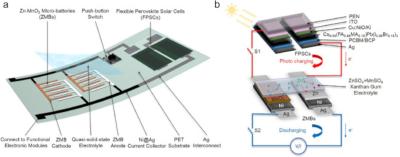Researchers from the University of Surrey's Advanced Technology Institute (ATI), KIOS Research and Innovation Center of Excellence at the University of Cyprus, China's Zhengzhou University, and the UK's National Physical Laboratory (NPL) have demonstrated a new photo-rechargeable system, which merges zinc-ion batteries with perovskite solar cells.
(a) device configuration and (b) working principle of the integrated flexible photo-rechargeable system. Credit: Energy Storage Materials
The new system could allow wearables to charge without the need to plug in. In fact, as little as thirty seconds of sunlight could boost the battery life of future smartwatches and other wearables by tens of minutes. The new environmentally friendly, photo-rechargeable system is unique because of its elegant design between the integrated battery and solar cell, allowing it to demonstrate high energy and volume density comparable to state-of-the-art micro-batteries and supercapacitors.
Jinxin Bi, a PhD candidate at ATI and the first author of the paper, said: "This technology provides a promising strategy for efficient use of clean energy and enables wearable electronics to be operated continuously without plug-in charging. Our prototype could represent a step forward to how we interact with wearables and other internet-of-things devices, such as remote real-time health monitors."
Dr. Yunlong Zhao, project co-lead and expert in batteries for wearables and implantables from the ATI, said: "The unique features in our ultrafast photo-rechargeable system could promote wide applications in self-powered wearable internet-of-things, autonomous power systems and emergency electronics. In addition, it will broaden the perception and insight of designing the next generation of miniaturized flexible photo-rechargeable systems."



Comments
Halide Perovskite based Photorechargeable supercapacitors
Check our latest work on halide perovskites based photo rechargeable supercapacitors for smart sensors applications. These devices can simultaneously harvest and store the renewable energy.
https://doi.org/10.1021/acsami.2c07440